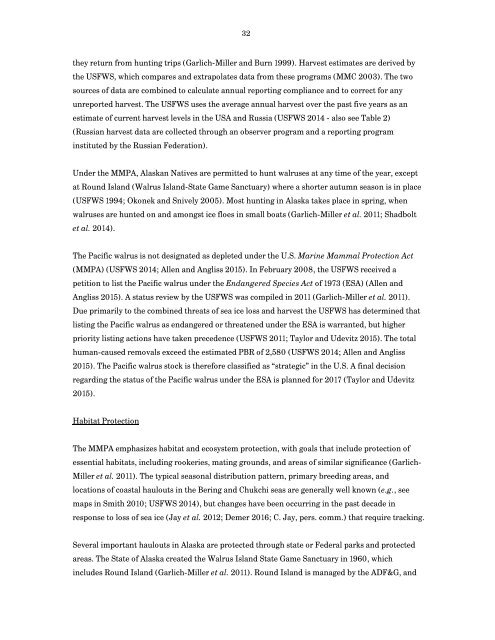The State of Circumpolar Walrus Populations
walrusreport
walrusreport
You also want an ePaper? Increase the reach of your titles
YUMPU automatically turns print PDFs into web optimized ePapers that Google loves.
32<br />
they return from hunting trips (Garlich-Miller and Burn 1999). Harvest estimates are derived by<br />
the USFWS, which compares and extrapolates data from these programs (MMC 2003). <strong>The</strong> two<br />
sources <strong>of</strong> data are combined to calculate annual reporting compliance and to correct for any<br />
unreported harvest. <strong>The</strong> USFWS uses the average annual harvest over the past five years as an<br />
estimate <strong>of</strong> current harvest levels in the USA and Russia (USFWS 2014 - also see Table 2)<br />
(Russian harvest data are collected through an observer program and a reporting program<br />
instituted by the Russian Federation).<br />
Under the MMPA, Alaskan Natives are permitted to hunt walruses at any time <strong>of</strong> the year, except<br />
at Round Island (<strong>Walrus</strong> Island-<strong>State</strong> Game Sanctuary) where a shorter autumn season is in place<br />
(USFWS 1994; Okonek and Snively 2005). Most hunting in Alaska takes place in spring, when<br />
walruses are hunted on and amongst ice floes in small boats (Garlich-Miller et al. 2011; Shadbolt<br />
et al. 2014).<br />
<strong>The</strong> Pacific walrus is not designated as depleted under the U.S. Marine Mammal Protection Act<br />
(MMPA) (USFWS 2014; Allen and Angliss 2015). In February 2008, the USFWS received a<br />
petition to list the Pacific walrus under the Endangered Species Act <strong>of</strong> 1973 (ESA) (Allen and<br />
Angliss 2015). A status review by the USFWS was compiled in 2011 (Garlich-Miller et al. 2011).<br />
Due primarily to the combined threats <strong>of</strong> sea ice loss and harvest the USFWS has determined that<br />
listing the Pacific walrus as endangered or threatened under the ESA is warranted, but higher<br />
priority listing actions have taken precedence (USFWS 2011; Taylor and Udevitz 2015). <strong>The</strong> total<br />
human-caused removals exceed the estimated PBR <strong>of</strong> 2,580 (USFWS 2014; Allen and Angliss<br />
2015). <strong>The</strong> Pacific walrus stock is therefore classified as “strategic” in the U.S. A final decision<br />
regarding the status <strong>of</strong> the Pacific walrus under the ESA is planned for 2017 (Taylor and Udevitz<br />
2015).<br />
Habitat Protection<br />
<strong>The</strong> MMPA emphasizes habitat and ecosystem protection, with goals that include protection <strong>of</strong><br />
essential habitats, including rookeries, mating grounds, and areas <strong>of</strong> similar significance (Garlich-<br />
Miller et al. 2011). <strong>The</strong> typical seasonal distribution pattern, primary breeding areas, and<br />
locations <strong>of</strong> coastal haulouts in the Bering and Chukchi seas are generally well known (e.g., see<br />
maps in Smith 2010; USFWS 2014), but changes have been occurring in the past decade in<br />
response to loss <strong>of</strong> sea ice (Jay et al. 2012; Demer 2016; C. Jay, pers. comm.) that require tracking.<br />
Several important haulouts in Alaska are protected through state or Federal parks and protected<br />
areas. <strong>The</strong> <strong>State</strong> <strong>of</strong> Alaska created the <strong>Walrus</strong> Island <strong>State</strong> Game Sanctuary in 1960, which<br />
includes Round Island (Garlich-Miller et al. 2011). Round Island is managed by the ADF&G, and


